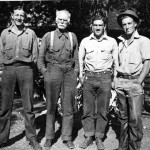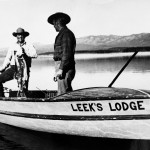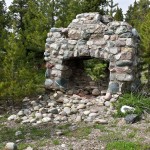Steven Leek first entered the Jackson Hole valley working as a trapper in 1888. At 30 years old, he had immigrated to the United States as a child, received education in Illinois and worked on a ranch in Nebraska. Upon arriving in Jackson Hole, Leek resolved to stay in the isolated and empty mountain valley, becoming one of the valley’s first permanent residents. He earned a living as a hunting guide, camping in various places and eventually building a small lodge on Leigh Lake. By 1898, he was ready to settle more permanently and filed on a homestead on Flat Creek, south of the emerging town of Jackson, then called Marysvale. His homestead was in an ideal location, with plentiful water access and quality soil. He began cattle ranching to supplement his income as a hunting guide. Over the next few decades, his cattle ranch would expand to 400 acres.
Leek’s prime homestead location in the open fields on Flat Creek and eventual fencing of 400 acres caused him to recognize a significant and growing problem in the valley. With the number of homesteads more than tripling since he first arrived in the valley, fences were crisscrossing the open areas like mazes. This made it very difficult for the wildlife to continue on established migration routes, and livestock filled up the best grazing areas. The result was thousands of stranded and starving elk, concentrated in groups and spreading disease. Leek recognized the value of these animals and the importance of their habitat through the lens of a hunting guide. With so many elk weak and dying, there would soon be little left to continuing the thriving big game hunting business in the valley. He was one of the first in the valley to suggest that there needed to be regulations and rules for how many animals each outfitter could claim. Without management for the health and wellbeing of the herd, Leek foresaw what few didn’t: there were limits to what felt like an infinite supply of wildlife.
In 1909, homesteaders in Jackson Hole began raising money to purchase hay to feed the elk in the winter. Those who could afford it donated any surplus hay. Leek regularly led hunting trips for the founder of Eastman Kodak, George Eastman, who gave Leek a camera as a thank you. Leek decided to use his camera to document the plight of the elk and to use the images on a national campaign to save the Jackson Hole herds. He is credited as being one of the first to recognize the negative effects of human settlement on wildlife, and one of the first to use photography as a medium of education. His numerous lectures, articles and photographs that were distributed to all the major publications in the county led to the founding of the National Elk Refuge on August 10, 1912. It is thought that without the efforts of Leek, the elk in Jackson Hole would have disappeared.
By 1924, Leek had established a successful guiding career, and decided to expand his business. He found a quiet cove on Jackson Lake, but the land fell under the jurisdiction of the Forest Service. Unlike his homestead, this federal land could not be purchased. Leek instead applied for a special use permit to build and manage “a resort for the accommodation of tourists” which would include a lodge, store and gas station. The Forest Service approved the application in 1925, and construction began on a central lodge and several smaller cabins. Although the property would mirror the appearance of a dude ranch, its use was much different. By 1927 the construction was complete and Leek would host his first clients.
During the summers, Leek’s Lodge was a summer camp for boys called “Teton Camp for Boys” and in the fall, it served as a home base for guided hunting trips. Leek operated the lodge with the assistance of both his sons, Holly and Lester. Summer camp activities included hiking, hunting, boating, fishing, and pack trips. Mindful of his earlier conservation success in the valley, Leek also established a “wildlife studies” program for the boys. Rates were $5.00 a day for all meals, a bed, and a boat. The lodge could hold up to 25 boys aged 14 through 19, from June through August. In 1934, Leek retired and suffered the loss of his son Lester. Holly kept up the operations as a hunting and fishing lodge, but ceased the boys camp activities. In 1943, the permit was renewed under the National Park Service with the establishment of the Jackson Hole National Monument. Shortly after World War II, Holly Leek sold the permit to Dr. N. E. Morad who kept Leek’s Lodge operational. The permit would change hands several times until Signal Mountain Lodge acquired the rights in 1975. The National Park Service removed the smaller cabins and kept the main lodge intact.
Today, only the crumbling remains of the main lodge chimney exists. A fire in 1998 burned the lodge to the ground, and the once bustling hunting camp gave way to the popular Leek’s Marina. Steven Leek’s homestead still exists south of Jackson, but it is now a private residence. Despite these two hidden pieces of valley history, Leek’s name lives on in his contributions to the welfare of the wildlife in the valley. The National Elk Refuge stands testament to his tireless efforts, and reminds us of the valley’s most important resources.
Text by Samantha Ford, Director of Historical Research and Outreach


